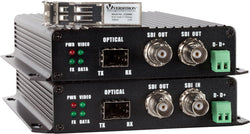HD-SDI Video to Fiber Installation Kits
High Definition-Serial Digital Interface (HD-SDI) is a technical standard for digital video transmission lines, which enables the transfer of uncompressed and unencrypted electronic audio and video signals. Almost all HD-SDI converters require coaxial cables.
VERSITRON HD SDI to Fiber Optic Converters are installation kits consisting of a transmitter, receiver, power supplies, SFP modules, and 100 meters of fiber optic cable.
Our SDI over Fiber converters utilize “broadcast quality” imaging; by installing them, you can increase the geographic distance of your network area.
VERSITRON has developed these tools so that you can easily and efficiently meet your data communication requirements. We are extremely customer centric and always adopt a personalized approach to help you achieve your project goals.
What is HD-SDI and Why is This Standard Popular in the Surveillance Industry?
HD-SDI Stands for “High Definition Serial Digital Interface” and is widely adopted by the surveillance industry. It is quite common to find HD-SDI security systems comprising cameras, SDI video transmitters and receivers, and coaxial cables.
Introduced by SMPTE in 1998, this standard was developed to support the HD resolution (720p and 1080i). It can support up to 1.5 Gbit/s bitrates. The 1.5 Gbit/s bitrates are again distinguished into two versions - 1.485/1.001 Gbit/s and 1.485 Gbit/s. Of this, 1.485/1.001 Gbit/s has been created with a factor of 1.001 to support the frame rates of 29.97 Hz, 59.94 Hz, and 23.98 Hz for video signals. This standard supports various NTSC systems - some of which are older and developed before 1998.
VERSITRON provides HDI to SDI Fiber Optic Converters in different specifications. All of our HD-SDI video transmitters and recorders are compatible with various SDI standards.
Features and Specifications of VERSITRON’s Hd Sdi to Fiber Optic Converters:
- High Definition Video Transmission
- 1G & 3G Fiber Optic SFP Modules Available
- LED Indicators for Instant System Monitoring
- Redundant Output for Local Monitoring
- RS-485 Return Data
- Transmit up to 20km without Optical Attenuation
- No Electrical or Optical Adjustments Required
- Stand-Alone or Rack-Mount in FVC18 Chassis
- Hot-Pluggable into the FVC18 Chassis
HD-SDI Standards Supported:
- SD-SDI (SMPTE 259M)
- ED-SDI (SMPTE 344M)
- HD-SDI (SMPTE 292M)
- Dual Link HD-SDI (SMPTE 372M)
- 3G-SDI (SMPTE 424M, 424M:2012)
- 6G-SDI (SMPTE ST-2081)
- 12G-SDI (SMPTE ST-2082)
Applications of HD SDI over Fiber Converters
SDI converters mainly find applications in professional video equipment. Here are some of the application areas:
- HD televisions
- Digital cinemas
- Video monitoring through big screen TVs or projectors
- DSLR cameras
Difference between HD-SDI, and other SDI Standards
- SD-SDI: The standard supports resolutions up to 576i as well as four different bitrates – 143 Mbit/seconds, 177 Mbit/seconds, 270 Mbit/s, and 360 Mbit/seconds. Of all these, 270 Mbit/s is adopted as the PAL/NTSC standard and its widescreen version can support bandwidth up to 360 Mbit/s.
- Dual Link HD-SDI: This is an upgraded standard of HD-SDI and it can support bitrates up to 3 Gbit/seconds and progressive resolution up to 1080p at diverse frame rates such as 50 Hz, 59.94 Hz, and 60 Hz.
- 3G-SDI: This standard was introduced in 2006 and later revised in 2012. 3G-SDI is a 3 Gbit/s interface and it supports all features of the Dual Link HD-SDI 1.485 Gbit/s interface. In real, it delivers only 2.970 Gbit/s and 2.970/1.001 Gbit/S. If looked at closely, you will find that 3G-SDI and Dual Link HD-SDI work similarly; however, the only difference is you need to use only one cable compared to two used by the earlier. This standard supports different mapping levels which are known as A, B-DL, and B-DS.
- 6G-SDI: This standard defines all requirements needed for transporting of 5.94 Gb/s and 5.94/1.001 Gb/s. 6G-SDI can support 4K 30 frames in a single link. The standard was introduced in 2015. Earlier 4 X HD-SDI signals or 4X 3G SDI signals were used to transmit 4K X60 frames per second. Now, everything is replaced by a single link 6G-SDI.
- 12G-SDI: The standard was introduced in 2015 and was revised in 2018. It assimilates High Dynamic Range (HDR) and Standard Dynamic Range (SDR) source formats into a multiplex or single 12G-SDI 10-bit interface. 12 G-SDI can support 8K 30 from dual links and 4K 60 from a single link.
Customer Support and Project Consultation
If you need assistance with the HD-SDI converters or any other VERSITRON products, please contact us by phone at 1-800-537-2296, feel free to use our LiveChat or send us an email to sales@versitron.com. We work closely with our customers to ensure that the correct product is selected and tailored to each specific application. We look forward to assisting you with your project.

